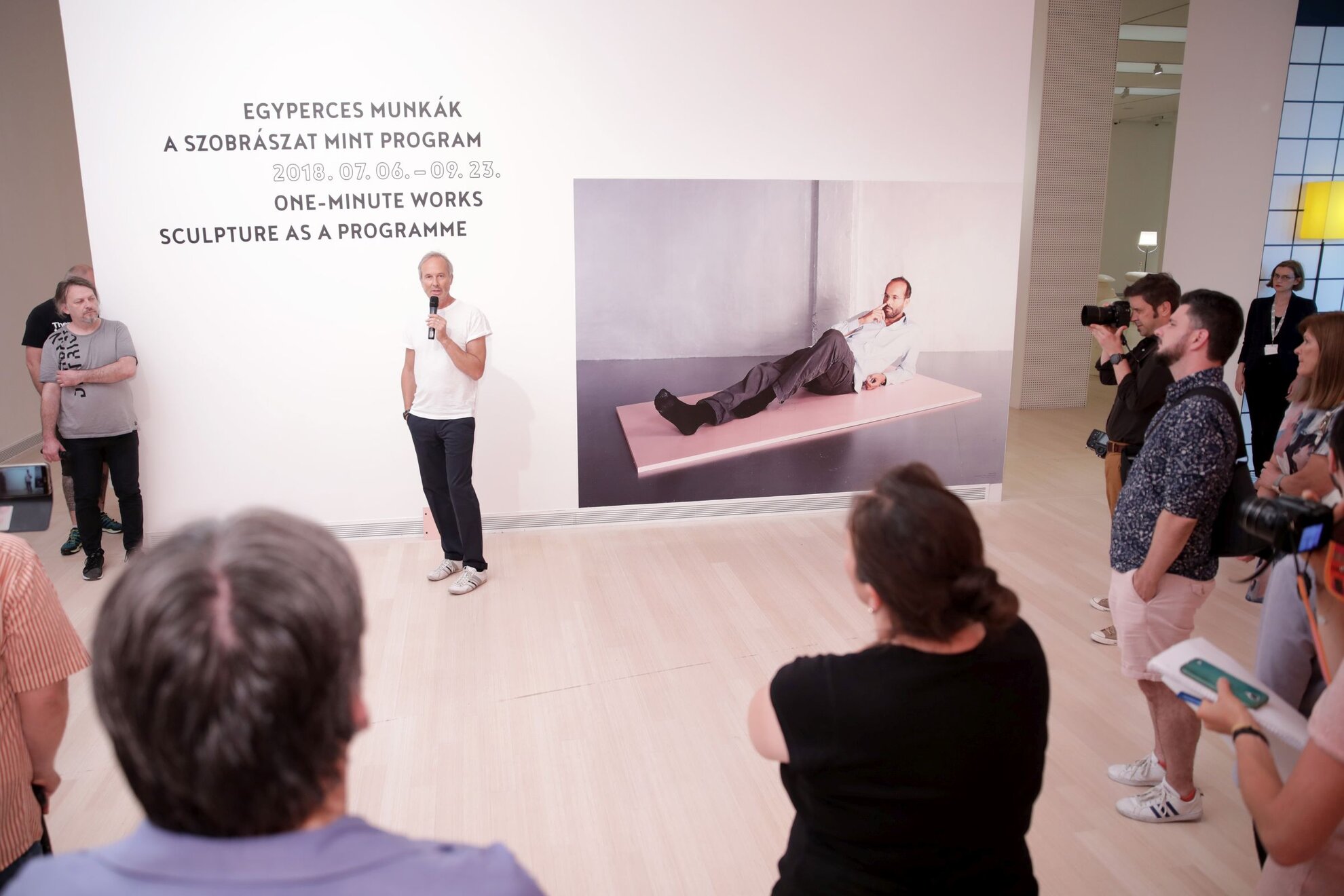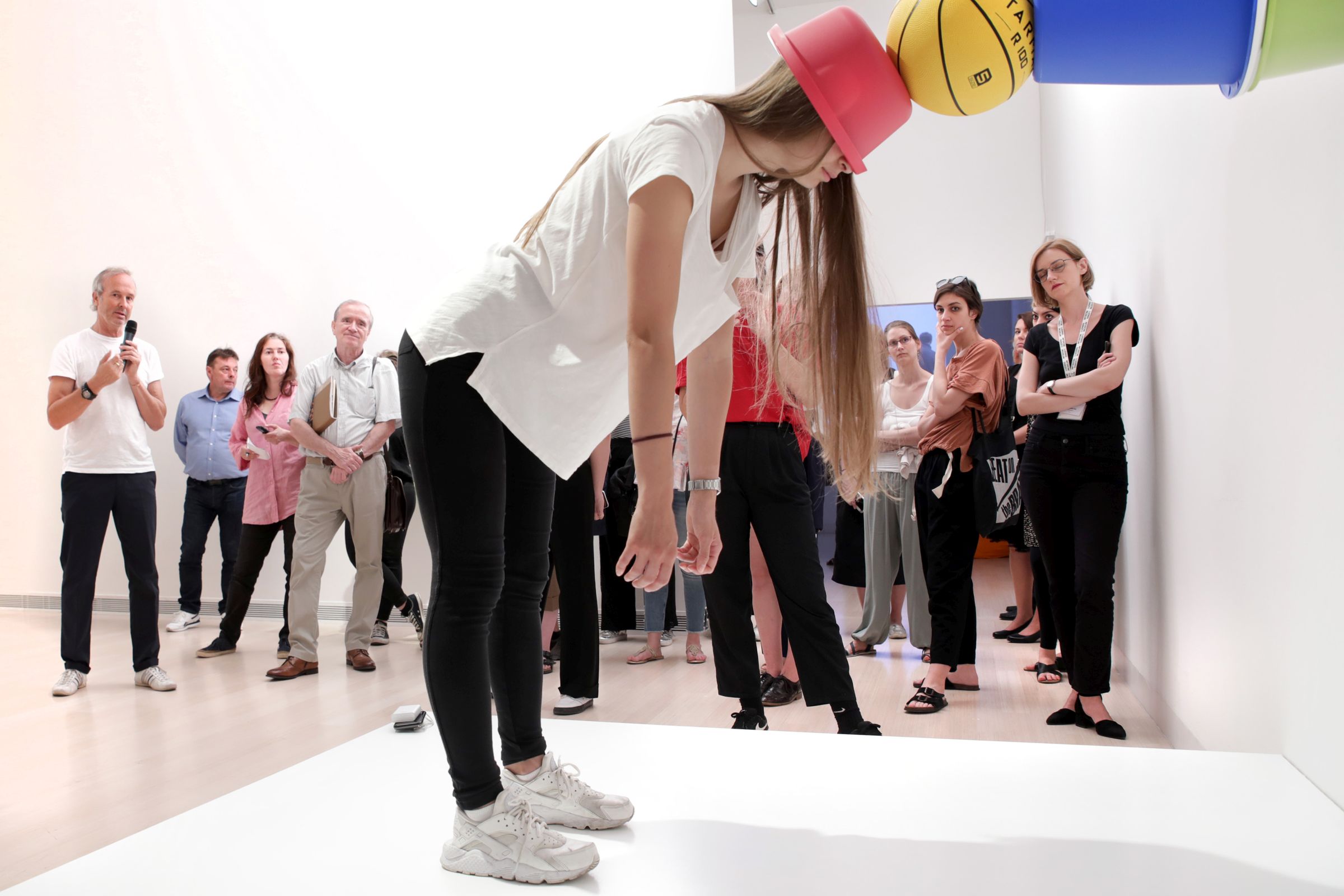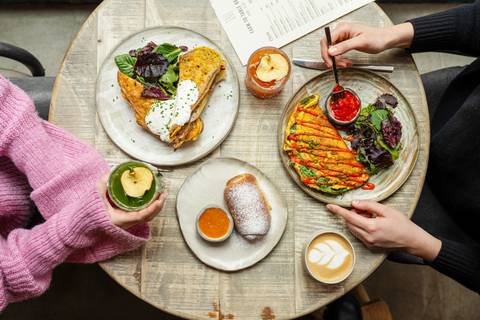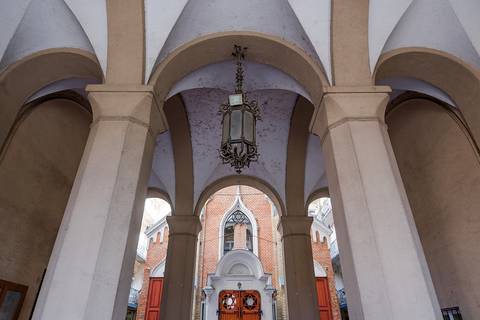Instant artworks are currently being brought to life at the Ludwig Museum in Budapest. A recently unveiled exhibition by acclaimed Austrian artist Erwin Wurm presents tennis balls, buckets, even a dustpan turned into momentary sculptures, as visitors interact with these ordinary objects inside the museum halls. This vast exhibition called “One-Minute Works” shows a selection of the artist’s oeuvre that embraces star collaborations with French fashion house Hermès and another with Red Hot Chili Peppers, whose 2003 Can’t Stop music video presents many of Wurm’s works.
A pile of books lies on a whitewashed platform at one of Ludwig Museum’s recently reopened exhibition halls, where artfully illustrated instructions prompt visitors to be part of the display. According to a graphic symbol and these specific instructions, viewers should step onto the elevated podium, pick up the books and hold them between their arms and legs for about a minute.

This animated exercise marks the opening scene of the museum’s current display by Erwin Wurm, who earned global fame with his avant-garde figures that break free from ordinary sculpting techniques. Presentations by Wurm often involve the audience and include everyday objects.

In an interview with We Love Budapest, Wurm explained that his initial inspiration for new sculpting methods came about during his studies at the University of Applied Arts in Vienna. “I realised that if I strictly followed the then-fashionable education guidelines, my works wouldn't stand out,” said the artist, whose sculptures have been travelling around the world’s most acclaimed exhibition venues and they have already appeared in major metropolises from New York to Paris and Moscow.

One of his most-applauded series is called One-Minute Sculptures, a project where common objects are deprived of their main function as they are transformed into artworks: a dustpan appears as a tool to measure masculinity, while an empty detergent bottle becomes an instrument for the audience to practise an ephemeral exercise.

“Visitors have the freedom to decide if they want to join my project or not,” the artist outlined. “If they follow my instructions to create a one-minute sculpture, it could surely change their perspective,” he added. “When a person visits an exhibition, they are normally just observers, but if viewers decide to be actively involved they become part of the subject matter. My ultimate goal is to question reality and put things into new context.”

Besides being picked up by Red Hot Chili Peppers, Wurm’s one-minute sculptures have also been recreated by the international design scene for an array of fashion photography.

In 2008, the Austrian master was commissioned by Hermès to create abstract artworks for the brand’s main showroom in Paris and select flagship stores around the world. These pieces are now also on view at the current Budapest exhibition, showing contorted mannequins sporting smarty garbed giant cubes on their upper bodies. Wurm agreed to this assignment on the condition that the works would be exhibited as an art project and wouldn’t be used for promotion.
Meanwhile, many of the sculptor’s creations place excessive consumption into the spotlight: clothes, cars, houses, furniture, even alcohol serve as addictive status symbols and are constant motifs in the artist’s oeuvre.

One exhibition hall at the Ludwig is equipped with antiquated cupboards and a chest of drawers, now all transformed into comfy cocktail cabinets. This intervention creatively changes the original function of the furniture mostly deriving from the 1950s and ‘60s. With this undertaking called the Drinking Sculptures, Wurm also refers to some of history’s great artists who liked a glass or two.

Transforming shapes is essential to Wurm’s collections. “I like destroying old, original structures and making them fat,” he says, referring to his dissected sculptures that portray large-scale objects with various levels of distortion. “I strongly believe that destruction can eventually lead to something good and new.” Such an artwork seen at the exhibition is an oversized piece of boxing glove casted in heavy bronze and coated with a thick layer of orange-coloured paint. “I’m often inspired by sci-fi or comic books and I like making observations from paradoxical perspectives, so the world that we know appears from a different angle,” explained the sculptor.

Presented in the adjacent hall, a photo series by the artist draws attention to mortality. Naked bodies of ageing men are contorted into postures that define Gothic and early Renaissance artworks. By re-enacting sacral poses for Wurm’s images, the portrayed characters become statues of their own bodies. For the final effect, the artist applies aggressive brushstrokes over the photos that disturbingly highlights declining body parts.

The closing act at this Ludwig phenomenon is a self portrait made of pickled cucumbers, considered a traditional food in Austrian cuisine. The artist cherishes the unique features of each vegetable also being part of a uniform entity. With this presentation, Wurm refers to people as individual living organisms that all belong to one human race.

“I like these overly simple shapes that are very diverse at the same time,” Wurm explained.“There are 100 million cucumbers in the world and you can’t find two that are identical. It’s the same with the world’s population. The connection between individuals and the masses is very interesting.”

As to how he sees the future of art in about 50 years, Wurm doesn’t have a clear vision in mind. “I have no idea. I don’t think anyone could tell. Art might disappear and will be replaced by something else,” he concluded.
The exhibition is on view through September 23rd.




